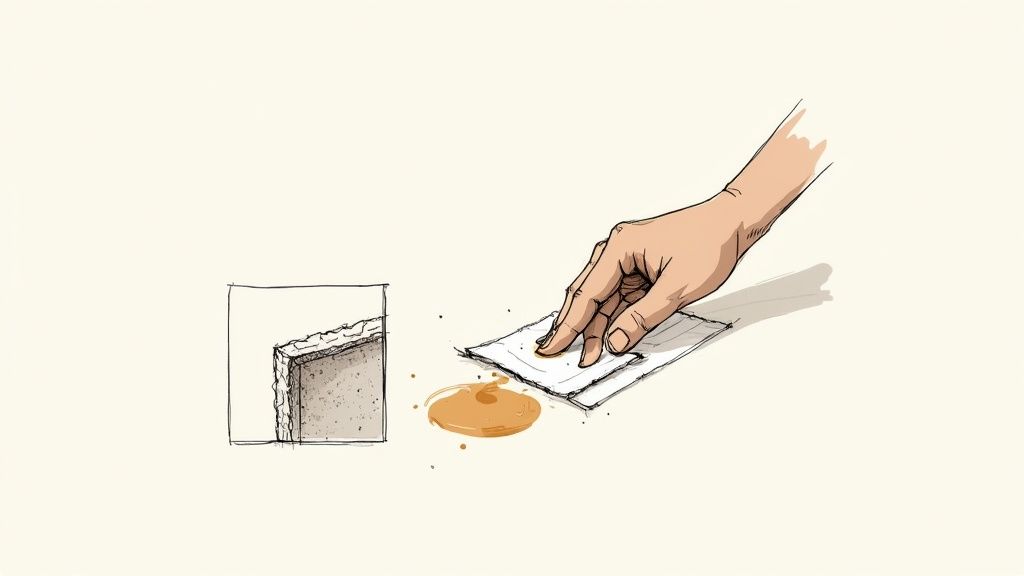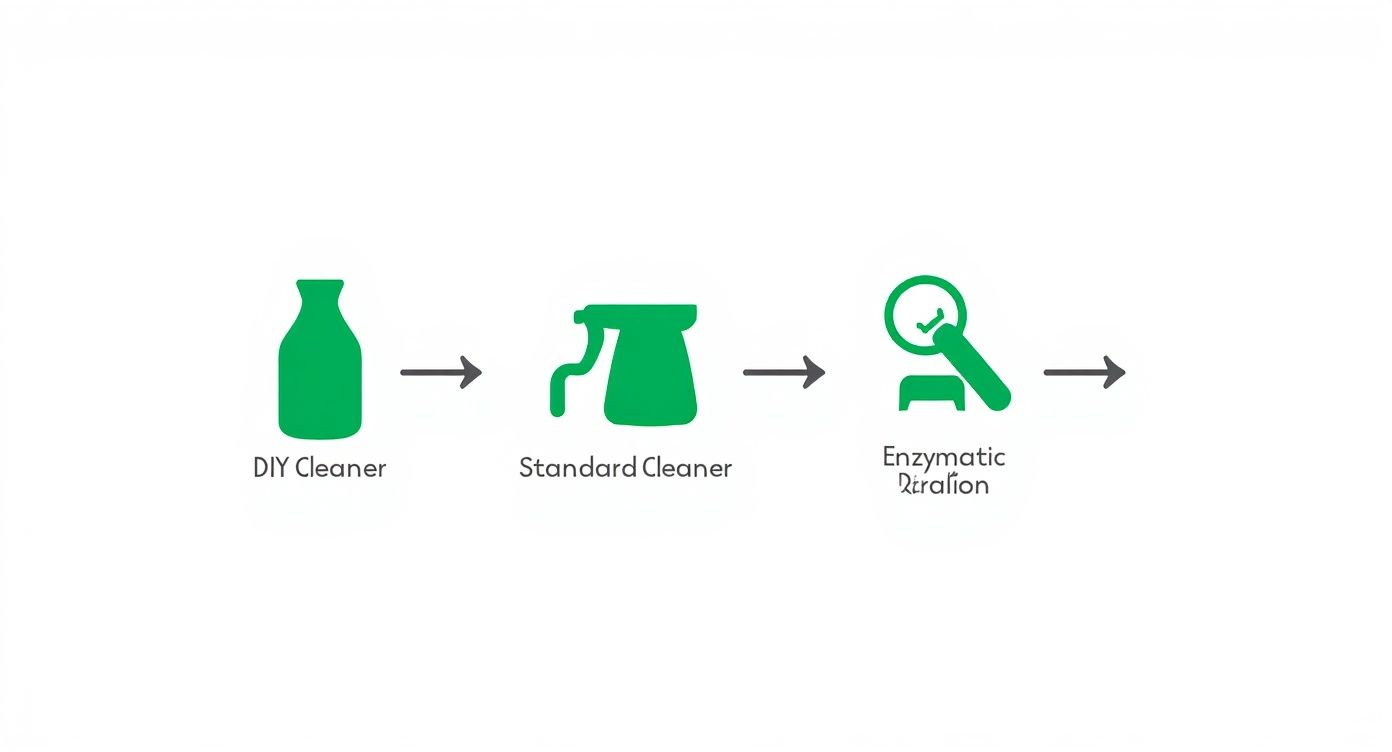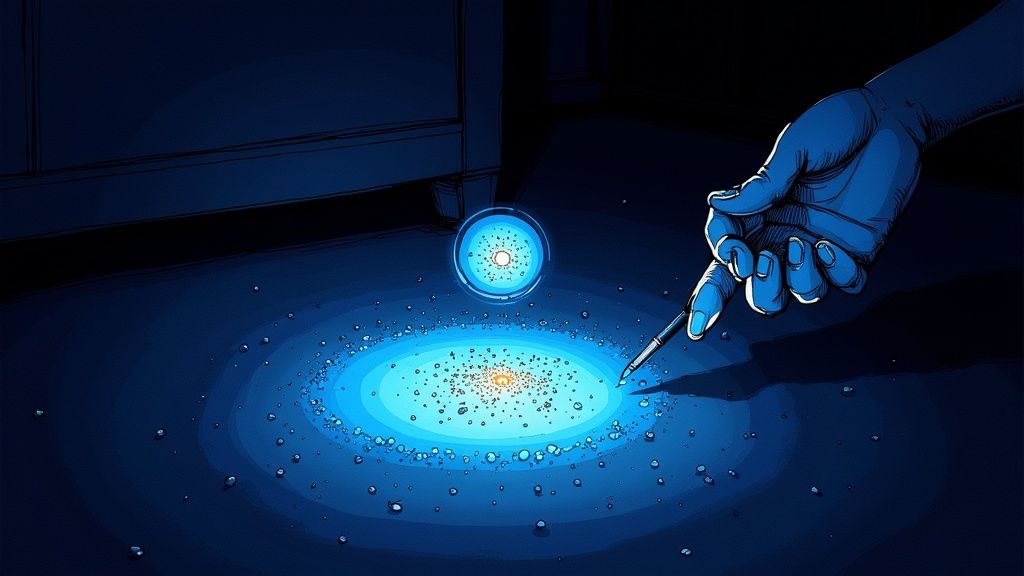That sinking feeling hits every dog owner eventually. But when you find a fresh urine spot, the first minute is absolutely critical. Your first instinct might be to panic, but what you do right now will determine whether you're dealing with a simple cleanup or a permanent stain.
What to Do the Moment You Find a Fresh Stain
Your immediate goals are simple: contain the mess and absorb as much liquid as physically possible.
Grab a thick stack of paper towels or a few clean, white cloths. Forget scrubbing—that's your enemy here. Scrubbing just grinds the urine deeper into the carpet fibers and, worse, into the padding underneath. Once it's in the padding, you've got a much bigger problem.
Instead, lay your towels over the wet spot and blot with firm pressure. The best way I've found to do this is to actually stand on the towels for a few seconds. Put your weight into it. Lift the towel, find a dry spot, and repeat. Keep going until the towel comes up nearly dry.

This simple blotting technique pulls the liquid up and out of the carpet, which is exactly what you want. You're preventing the stain from spreading and removing most of the urine before you even think about cleaning products.
To help you react correctly under pressure, here’s a quick-reference table for those first crucial moments.
Immediate Response Plan for Fresh Urine Stains
| Action to Take | Why It Works | Common Mistakes to Avoid |
|---|---|---|
| Blot with a dry, white cloth. | Wicks moisture up and out of carpet fibers. | Scrubbing. This forces urine deeper. |
| Apply heavy, steady pressure. | Maximizes absorption into the cloth. | Lightly dabbing. It's not effective. |
| Repeat with fresh, dry sections. | Prevents re-saturating the carpet. | Using a dirty or colored towel. |
| Keep it cool. | Prevents the stain from setting. | Using heat or steam. |
Following this simple plan sets you up for success when you move on to the actual cleaning and deodorizing steps.
The Critical Mistake to Avoid
Whatever you do, do not reach for a steam cleaner. I see people make this mistake all the time, and it's a disaster for your carpet.
The high heat from a steam cleaner will literally cook the proteins in the dog urine. This causes a chemical reaction that permanently bonds the stain and the odor to your carpet fibers.
Once a urine stain is heat-set, it's practically impossible to remove. Always, always stick to cold or room-temperature treatments for fresh accidents.
Why Blotting Works Best
There's a reason every professional will tell you to blot, not rub. Proper blotting uses pressure to create a wicking action, drawing the liquid upward into your towel. It’s the single most effective first response.
According to the experts at Sears Clean, you have to blot immediately with clean towels and firm pressure to avoid pushing the urine deeper. By patiently doing this, you remove the bulk of the problem before it has a chance to soak in and become a lingering odor issue.
Choosing Your Cleaning Weapon Wisely
Walking down the cleaning aisle can make your head spin, but the science behind getting dog urine out of your carpet is actually pretty simple. Your go-to household carpet cleaner might be great for dirt and spilled coffee, but it’s just not built to handle pet accidents.
Most of the time, these standard cleaners just slap a fragrance over the smell. This leaves the real culprit—the uric acid crystals—to fester deep down in your carpet fibers.
Why Enzymatic Cleaners Are a Game-Changer
This is where enzymatic cleaners come into play. I like to think of them as tiny, microscopic cleaning crews. These formulas are packed with beneficial bacteria that produce enzymes. Their one job? To hunt down and literally break apart the organic proteins and uric acid in urine.
They don't just cover up the smell; they completely dismantle it at a chemical level. This is absolutely critical if you want to stop your dog from returning to the same spot to do their business again. The demand for cleaners that actually work is huge—the global market for pet-safe cleaning products was projected to hit roughly USD 6.49 billion. You can dig into more data on this from Future Market Insights.
The DIY Alternative: Vinegar and Baking Soda
For those who prefer a homemade approach, a mix of white vinegar and baking soda is often the first thing people try. It's a popular first line of defense, and for good reason.
The vinegar helps neutralize the ammonia, which is what causes that initial sharp odor. After the vinegar has done its work, the baking soda comes in to soak up any remaining moisture and absorb those lingering smells. While this method can work pretty well on fresh, minor accidents, it usually doesn't have the muscle to knock out set-in odors for good.
Key Takeaway: A DIY vinegar solution can neutralize ammonia, but it can't break down the stubborn uric acid crystals that cause odors to return. For a permanent fix, an enzymatic cleaner is your most reliable option.
The vinegar and baking soda trick is a solid starting point, though. We actually have a whole guide on the right way to use baking soda to remove stains from carpets.
Ultimately, the key to winning the war against pet stains is understanding the difference between just masking an odor and truly eliminating it.
Your Deep Cleaning Playbook for Urine Stains
Alright, you've got your cleaner in hand. Now it's time to actually tackle that stain. Getting dog urine out of a carpet is more than a quick spray-and-wipe job; you need a solid game plan to kill the stain at its source—which is almost always deep down in the carpet padding.
The single biggest mistake I see people make is not using enough cleaner. You have to remember, the urine soaked down into the carpet, so your cleaning solution needs to follow that exact same path. Be generous with it. Apply enough cleaner to cover the surface stain and a little extra around the edges, because urine almost always spreads out underneath the surface.
Let Your Cleaner Do the Heavy Lifting
Once you’ve saturated the spot, the most important—and hardest—part is to just walk away. This is called dwell time, and it’s not optional. You have to give your cleaner enough time to actually work its magic on a molecular level.
Don't rush this. A good cleaner needs at least 10-15 minutes of dwell time to start breaking down the uric acid crystals. For older, more stubborn stains, I've seen homeowners have great success letting it sit for an hour or even longer. It can make all the difference.
During this waiting period, the enzymes or other agents in your cleaner are literally dismantling the compounds that cause that awful smell. If you start blotting it up too early, you're just pulling up the cleaner before it has a chance to finish its job.
This infographic does a great job showing how different cleaners work.

As you can see, enzymatic cleaners are designed to get microscopic, which is exactly why giving them proper dwell time is so critical. If you want to get into the nitty-gritty, our guide on what an enzymatic cleaner is really breaks down the science behind it.
The Final Rinse and Extraction
After you've waited patiently, it's time to get all that liquid—both the cleaner and the dissolved urine—out of your carpet.
Start by blotting the area with a stack of clean, dry towels. Press down hard. Stand on it, even. The goal is to absorb as much of the moisture as you possibly can.
Next, you'll want to do a gentle "rinse." Just dampen a new, clean cloth with a little cool water and blot the area again. This helps pull up any leftover cleaning residue that could become sticky and attract dirt later on.
Finally, place a thick stack of dry paper towels over the spot, put something heavy on top (like a stack of books), and leave it be for several hours or overnight. This last step wicks out the deep-down moisture, which is absolutely key to preventing that soggy, musty smell from developing later.
How to Tackle Old Stains and Phantom Smells
So, what about the accidents you stumble upon weeks later? Or that stubborn, phantom smell that loves to reappear on humid days? Getting dog urine out of carpet is a whole different ballgame when the stain is old and has had time to set. These situations call for a bit more muscle, starting with some detective work.
The biggest problem with old stains is that you often can't see the full extent of the damage. What looks like a small spot on the surface has likely spread out underneath. This is where a UV blacklight becomes your secret weapon.
In a dark room, flick that light on and watch the salts in the dried urine glow. It's often shocking to see just how many spots you've missed and how large they really are.

Once you’ve mapped out all the culprits, you can't just spray your cleaner on top and call it a day. The urine has dried, and the uric acid crystals are lying dormant. To get rid of them for good, you have to wake them up first.
Rehydrating the Stain
The trick is to gently mist the glowing areas with cool water from a spray bottle. Your goal isn't to soak the carpet, just to get it slightly damp. This simple step rehydrates those stubborn uric acid crystals, making them vulnerable to your enzymatic cleaner again.
After you've dampened the spot, it's time to follow the same deep cleaning process you'd use for a fresh stain:
- Saturate every inch of the stained area with a high-quality enzymatic cleaner. Don't be shy with it.
- Let it sit. Old stains need a long dwell time, sometimes an hour or even more, to let the enzymes do their work.
- Blot the area thoroughly with clean towels to pull out as much of the liquid as you possibly can.
Even with the best cleaning job, a lingering odor can sometimes stick around. For more in-depth strategies on getting rid of that last bit of smell, check out this proven guide to removing urine smell.
When the Odor Just Won't Quit
If you've done everything right and that smell still comes back to haunt you, you're probably dealing with a much deeper issue. More than likely, the urine has soaked completely through the carpet and into the padding—or worse, the subfloor itself.
Expert Insight: At this point, no amount of surface cleaning is going to fix the problem. The source of the odor is now underneath your carpet. You'll either have to pull back the carpet to treat or replace the padding and seal the subfloor, or it's time to call in a professional for a deep extraction.
Preventing Future Accidents and Protecting Your Carpet
Getting a single stain out is one thing, but if you're stuck in a cycle of cleaning up accidents, you're only fighting half the battle. To truly win the war, you have to figure out why it's happening in the first place.
When a well-behaved dog suddenly starts having accidents, it's almost always a sign that something bigger is going on. Before you chalk it up to bad behavior, a trip to the vet is your first and most important step. Things like urinary tract infections or incontinence can pop up unexpectedly and are often the real culprit.
Once you've ruled out any medical issues, you can start looking at behavior. Is your dog only having accidents when you're not home? This is a classic sign of stress. Digging into how to reduce dog separation anxiety can make a world of difference, not just for your carpets, but for your dog's peace of mind.
Proactive Carpet Protection Strategies
While you work on the root cause, you can also take some practical steps to guard your floors against the next mess.
Applying a high-quality carpet protectant is like giving your carpet an invisible raincoat. It helps liquids bead up on the surface instead of immediately soaking in, which buys you precious time to grab the paper towels. We cover this in more detail in our guide on how to protect your carpet from stains.
Another smart move? Place waterproof mats in your dog’s favorite hangouts—under their bed, around their food and water bowls, or near the door. It's a simple physical barrier that can save you a ton of cleanup headaches.
A proactive approach is always better than a reactive cleanup. Creating an environment that discourages accidents and protects your surfaces will save you significant time, money, and stress in the long run.
And you're not alone in this struggle. The market for pet odor solutions is massive for a reason. In 2023, the U.S. pet odor control industry was valued at roughly USD 6.47 billion, and that number is only going up. You can discover more insights about this growing industry on Grand View Research.
Still Have Questions About Dog Urine Cleanup?
Even after you've tackled a stain, it's totally normal to have a few more questions pop up. Getting dog urine completely out of a carpet can feel like a science experiment gone wrong, but the answers are usually more straightforward than you think. Let's walk through some of the most common head-scratchers pet owners run into.
One of the biggest questions I hear is about using heavy-duty cleaning machines. Specifically, can you just zap a fresh stain with a steam cleaner? The short answer is a hard no. Please, don't do it. That intense heat will actually cook the proteins in the urine, chemically bonding them to your carpet fibers. You’ll set that stain and the smell for good.
Now, a standard carpet shampooer—one without a heat function—is a different story. It can be useful, but only for a final rinse after you've already thoroughly treated the spot with a good enzymatic cleaner.
Common Cleanup Problems
A lot of people ask me if homemade solutions like vinegar and baking soda really work. For a brand-new accident, they're actually a pretty decent first line of defense. The vinegar does a good job of neutralizing the ammonia smell, and baking soda is fantastic at pulling up moisture and absorbing odors. It's a solid surface-level fix.
But here's the catch…
Key Takeaway: DIY cleaners don't break down the uric acid crystals. These nasty little crystals are the real source of that lingering smell that keeps coming back, and an enzymatic cleaner is the only thing that truly destroys them at a molecular level. This is what stops your dog from being drawn back to the same spot.
So, how do you know if the problem has soaked deeper than the surface? The biggest red flag is a smell that just keeps returning, especially on humid days. That’s a tell-tale sign the urine has seeped into the carpet padding.
If you want to play detective, a UV blacklight is your best friend. Turn off the lights, shine it on the carpet, and it will reveal the true size of the stain. If that glowing spot is way bigger than what you can see in normal light, you've got a padding problem on your hands.
Why Does My Dog Keep Going in the Same Spot?
This is easily the most frustrating part of the whole ordeal. Your dog keeps returning to the scene of the crime, and it's not because they're being stubborn or naughty—it's pure instinct.
A dog's sense of smell is thousands of times more powerful than ours. If even the tiniest, microscopic trace of that old urine scent is left behind, that spot basically has a giant neon sign flashing "TOILET HERE" in your dog's mind.
This is exactly why just spraying some air freshener or using a standard carpet soap is a battle you'll never win. You have to completely obliterate those scent molecules. That's why I can't stress this enough: a true enzymatic cleaner is non-negotiable. It actually digests and eliminates the source of the odor, leaving nothing for your dog's super-sensitive nose to find.
When you're dealing with deep-set stains and odors that just won't give up, sometimes you need to call in a professional. At Citrus Carpet Cleaning Buford, we use specialized, citrus-based solutions designed to break down the toughest pet messes without leaving behind the sticky, dirt-attracting residues other cleaners do.
If you're ready to give your carpets a truly fresh start, learn more about our pet odor and stain removal services.

